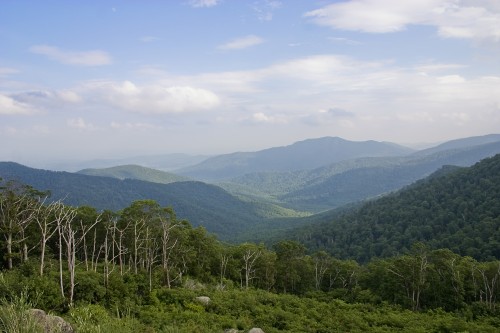
Courtesy of JSmith on Flickr
The Appalachian Mountains conjure up images of rustic living, long-distance hiking and banjos. The range formed back in the Paleozoic Era and now stretches from Newfoundland, Canada to Alabama. Wandering through its rough terrain is the famous 2,174 mile Appalachian Trail. Throughout time humans have been nurtured by these mountains, developing vibrant cultures within their shadows.
While the northern Appalachian culture has lost much of its unique regional flavor, the communities nestled in the Blue Ridge and Smokey Mountains of southern Appalachia have clung to their rural roots. These areas are far more isolated and distant from growing urban centers. As a result, their traditions have been well-preserved.
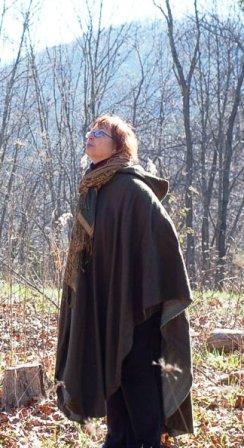
Byron Ballard
at the Celtic Tree Workshop
Deep within the heart of this southern world, there lives the unexpected: a thriving Pagan community. To get a better understanding of this area and just how the Appalachian way informs the practice of Paganism I turned, quite literally, to a Village Witch. Byron Ballard, a senior priestess of Mother Grove Goddess Temple, lives in the small city of Asheville, North Carolina. She was born and raised in the Appalachian countryside and has since become a recognizable and respected figure in the community.
Heather: Southern Appalachia has a rich culture that is distinct and recognizable. Do you see this regional color influencing the practice of Paganism in the area? How?
Byron: Here in Appalachia we are not far from our agricultural roots as in other parts of the country. We remain close to the land. I grew up in a rural cove where most people gardened and preserved food. The use of curative herbs and food was common less than a generation ago–many of us don’t think of it as merely a historical leftover. So for Appalachian Pagans, being close to the land is an accident of birth that is beautiful and significant to us.
H: Historically speaking, the Cherokee Indians populated this area prior to European colonization. Their influence is still felt up and down the Blue Ridge and Smokey Mountains. Does traditional Cherokee culture inform the Appalachian Pagan’s spiritual practice today?
B: I am currently researching what I call the three strands of Appalachian Folk magic: one of which is Cherokee. Unlike other regions, southern Appalachia saw a gentler transition from the dominant Indian culture to American culture. What I mean by that is that the colonists here did not aggressively push into the region. The two cultures lived peacefully and independently which led to gentle integration and cooperation. This continued for over a century.
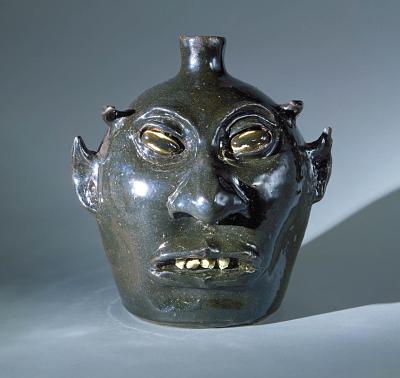
Smithsonian American Art Museum
Folk Artist Lanier Meaders
Appalachian Face Jug
As a result, we share many traditions with the Cherokee, such as herbalism and oral storytelling. I also believe that the folk tradition of healing waters comes from Cherokee roots. In addition, because of Appalachia’s isolation, people have a strong sense of self-reliance which has allowed for the development of wonderful folk art, music, and textiles. This is common to all the cultures of Appalachia.
H: Today, most of the southern Appalachian chain is within the Bible belt. But yet, you live in an area with a thriving Pagan population. What does the Pagan community look like in Asheville?
B: I do not have exact figures. In the Buncombe County area, I suspect about 1000 people self-identify as Pagan of some sort. Specifically speaking, Asheville has long been an eclectic enclave and is known for having a vibrant Pagan influence. In addition, there is a segment of the local population that doesn’t identify as Pagan but rather defines their spirituality in terms of nature. These Jews, Christians, and New Age enthusiasts do not go to church or temple to unite with their concept of the divine. They go hiking.
You have to understand that the mountains here are some of the oldest in the world. We have two of the oldest rivers, the New River and the French Broad, running through the area. It is almost as through you can hear the area hum with a deep low sound. It calls people in. People that hear become connected to it.
H: As with most of the country, there has been a growing need for interfaith work. You’ve been a key player in making this happen in Asheville. Despite the southern setting, your interfaith work has been tremendously successful. How did a small southern mountain city find its interfaith movement?
B: The interfaith community was born when a woman named Mary Page Sims, the wife of an Atlanta Episcopal Bishop, retired to Hendersonville, North Carolina. In the 1990s, she started a local cooperative circle for United Religious Initiative. I met her shortly after and a group of us began a second circle–Greater Asheville URI Cooperation Circle.
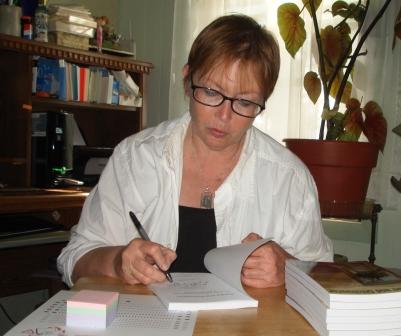
Around 2005, the Asheville circle was disbanded, due to a lack of leadership and general interest in interfaith work. Several years later, the Brotherhood at our local Reform congregation wanted to widen their long-term Jewish-Christian dialogue group. They chose congregational leaders from a very diverse cross-section of the Asheville spiritual community and hired a consultant to lead the group through a process to determine whether there was interest in interfaith work. We formed the Mountain Area Interfaith Forum which is now in its fifth year of operation.
H: I met you through our work with Lady Liberty League on the Bumcombe County school case that concerned religious freedom. After working on this particular case, you became involved in yet another very focused interfaith board. Tell me about that.
B: After the Buncombe County School Board met to establish a protocol for dealing with religious material within the schools, the superintendent, Tony Baldwin created a Faith-Based Leadership Advisory Council. I serve on the committee with other leaders from all faiths. Now, when anyone in the school district has a concern or question about a religious observance or tradition, we are available to provide information and support. Tony Baldwin has been extremely supportive as the County moves through this cultural transition from assumed religious homogeneity to the embracing of its diversity.
H: Thank You, Byron.
Over the years, Byron has worked tirelessly to educate others about beauty of Goddess spirituality and its symbiotic relationship with Appalachian folk tradition. This fall she taught classes at the Southeast Woman’s Herbal Conference, a weekend celebrating folk tradition, herbalism and the ways of the wise woman, held in Black Mountain, North Carolina. Byron also co-founded The Coalition of Earth Religions for Education and Support or CERES, a social networking organization for local Appalachian Pagans. She has been interviewed for or contributed to numerous Pagan magazine including Witches and Pagans and Hoodoo & Conjure Quarterly.
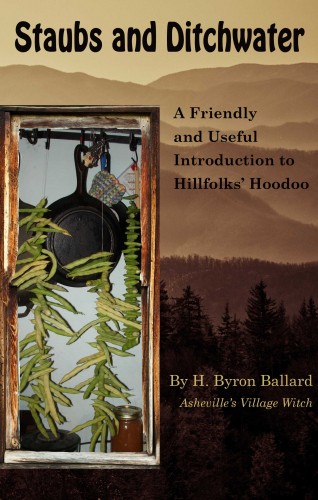 Much of her outreach work has been done through her writing. She was a columnist, the Village Witch, for the local Gannett daily paper, The Asheville Citizen-Times and the Mountain Xpress. More recently, Byron published a book Staubs & Ditchwater: An introduction to Hillfolks’ Hoodoo. The book included her paper entitled “Hillfolk Hoodoo and the Question of Cultural Strip-mining” which, in 2007, she presented at the Harvard Colloquium “Forging Folklore: Witches, Pagans, and Neo-Tribal Cultures.”
Much of her outreach work has been done through her writing. She was a columnist, the Village Witch, for the local Gannett daily paper, The Asheville Citizen-Times and the Mountain Xpress. More recently, Byron published a book Staubs & Ditchwater: An introduction to Hillfolks’ Hoodoo. The book included her paper entitled “Hillfolk Hoodoo and the Question of Cultural Strip-mining” which, in 2007, she presented at the Harvard Colloquium “Forging Folklore: Witches, Pagans, and Neo-Tribal Cultures.”
Not all regions of the U.S. are fortunate enough to have such a rich culture heritage, one that lends itself so well to the practice of a Pagan spirituality. In that way, Southern Appalachia is a true national treasure. Byron herself would be the first to admit, there’s just something in the spirit of those mountains. Having visited, I would have to agree.
The Wild Hunt is not responsible for links to external content.
To join a conversation on this post:
Visit our The Wild Hunt subreddit! Point your favorite browser to https://www.reddit.com/r/The_Wild_Hunt_News/, then click “JOIN”. Make sure to click the bell, too, to be notified of new articles posted to our subreddit.
I am currently researching what I call the three strands of Appalachian Folk magic: one of which is Cherokee.
I would hazard a guess that the other two are African and European, but I’d like to hear more about that.
More likely German and Scots-Irish simply due to the demographics, but I’d be interested in hearing what Byron has to say on the subject.
The other side of those mountains, up here in NE TN also has a Pagan community although it’s very much hidden due to hostility on the part of the Christian community. But it’s still there…. 🙂
I can’t imagine every living anywhere but in these mountains. West Virginia is my home, although it has it’s own set of problems, it is where the earth has welcomed me in all it’s myriad ways.
Wonderful piece!!
I loved my time living in West Virginia, 4 years of the best people and a landscape that pulses with a living spirit.
Pleasantly surprised to see a piece about my homeland featured on the Wild Hunt. Cheers!
Ms Ballard guesstimates the number of Pagans in Buncombe County to be around one thousand. Based on the number of people who come into the book store where I work every week and buy New Age or Pagan or occult texts, the number might actually be higher. 🙂